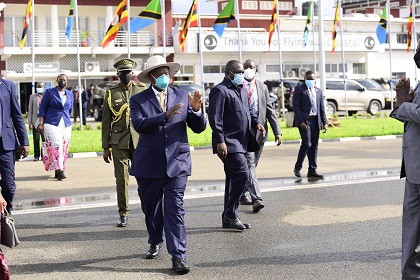
By Executive Editor
In October, Kira Municipality MP Ssemujju Nganda raised concerns about President Museveni’s ongoing absence from important international meetings that he previously attended.
Ssemujju pointed out several significant meetings that the President has missed, opting instead to send representatives, including the recent United Nations General Assembly.
“We had the United Nations General Assembly recently, and the President was represented by the Vice President; we had a meeting in China, and again, our President was represented, and you have just said even for the Commonwealth,” Ssemujju said.
Ssemujju speculated that the president’s absence might be due to health issues and called for him to undergo a health checkup.
However, research has shown that older people do not prefer traveling by air.
Museveni turned 80 in October 2024.
Research first published in 2002 by the British Geriatrics Society titled “Air treval in older people” suggests that although air travel is one of the safest means of transport, the environment within the aircraft cabin may have deleterious physiological effects on passengers, especially those with underlying medical problems and those who are old.
James Low of the Department of Geriatric Medicine, Prince of Wales Hospital, and Dnaiel Chan of the Department of Aged Care and Rehabilitation, Bankstown Hospital, Australia, say older people may encounter various problems during a long journey.
Cabin pressure
Most planes cruise between 28000 and 45 000 feet (flight altitude) above sea level, while cabin pressures are maintained between the equivalent of 6000 and 8000 feet (cabin altitude) above sea level. Cabin oxygen starts decreasing at a flight altitude of about 22500 feet. At cabin pressure of 6000 feet, the alveolar oxygen tension is 71 mmHg, while at 8000 feet it is 59 mmHg. Thus, at cruising altitude, cabin oxygenation is almost invariably diminished and may pose a health risk to passengers with anemia, cardiopulmonary illnesses, and other vascular conditions.
The low cabin pressure also leads to the expansion of gases (Boyle’s law). This has clinical implications, especially if gas is trapped in body cavities such as the sinuses, middle ear, gut, pleural cavity, eyes, tooth fillings, and skull.
The cramped conditions, prolonged immobility (especially in long-haul flights), constant noise and vibration, and intermittent air turbulence may be disconcerting to the older traveler and can cause oedema of the lower limbs (jet flight leg) or deeper vein thrombosis as a result of venous stasis.
Psychologically, the fear of flying is common in elderly people and may lead to hyperventilation and anxiety. Anxiety provocation situations include, among others, airplane takeoff and landing.
Neurological conditions that can occur in the plane include seizures and strokes. Syncope. The most common in-flight medical emergency is syncope from various causes. Passengers, especially elderly travelers, are more prone to syncope because of prolonged sitting, dehydration, and alcohol use, which can lead to postural hypotension.
In conclusion, the research says that “more older people are traveling by air, and most will complete their journeys uneventfully.”






